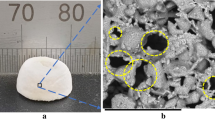Summary
The method of heat-denaturation and trypsin digestion was used to dissect bone biochemically into mineral-protected and mineral-unprotected pools of collagenous matrix. It was found that varying the particle size of the bone powder had a profound effect on the results. Using mature bovine cortical bone, the observed pool of “unmineralized” (mineral-unprotected) collagen could be varied from 2% to more than 60% of the total bone collagen simply by decreasing the particle size of the bone sample from greater than 1 mm to less than 38 μm. No major differences were seen in the contents of hydroxypyridinium cross-links between the collagens of the trypsin-soluble and trypsin-insoluble pools from the fine powders, contrary to earlier reports. A trend to a higher content of these cross-links was evident, however, in the very small collagen pool extracted from the coarsest bone particles. Similar extraction differences were noted using bacterial collagenase to probe for mineral-protected vs. mineral-unprotected domains of bone collagen. In summary, the biochemical dissection results appear largely to be an artifact of the powdering technique, the shear energies of which presumably destroy the intimate physical relationship between the mineral crystallites and the collagen fibrils at the fractured surfaces of the bone particles. As the fractured surface area increases with decreasing particle size so the fraction of protease degradable collagen increases. Since powdering is routinely adopted for many structural studies on both the mineral and organic phases of bone, the findings on finely powdered bone should be interpreted cautiously.
Similar content being viewed by others
References
Fujimoto D, Moriguchi T (1978) Pyridinoline, a non-reducible crosslink of collagen. Quantitative determination, distribution, and isolation of crosslinked peptide. J Biochem 83:863–867
Eyre DR, Oguchi H (1980) The hydroxypyridinium cross-links of skeletal collagens: their measurements, properties, and a proposed pathway of formation. Biochem Biophys Res Commun 92:403–410
Kuboki Y, Tsuzaki M, Sasaki S, Liu CF, Mechanic GL (1981) Location of the intermolecular cross-links in bovine dentin collagen, solubilization with trypsin and isolation of cross-link peptides containing dihydroxylysinonorleucine and pyridinoline. Biochem Biophy Res Commun 102:119–126
Banes AJ, Yamauchi M, Mechanic GL (1983) Nonmineralized and mineralized compartments of bone: the role of pyridinoline in nonmineralized collagen. Biochem Biophy Res Commun 113:975–981
Mechanic GL, Banes AJ, Henmi M, Yamauchi M (1985) Possible collagen structural control of mineralization. In: Butler WT (ed) The chemistry and biology of mineralized tissues. Ebsco Media, Birmingham, Alabama, p 98
Mechanic GL, Young DR, Banes AJ, Yamauchi M (1986) Nonmineralized and mineralized bone collagen in bone of immobilized monkeys. Calcif Tissue Int 39:63–68
Bateman JF, Chan D, Mascara T, Rogers JG, Cole WG (1986) Collagen defects in lethal perinatal osteogenesis imperfecta. Biochem J 240:699–708
Eyre DR, Koob TJ, Van Ness KP (1984) Quantitation of hydroxypyridinium crosslinks in collagen by high-performance liquid chromatography. Anal Biochem 137:380–388
Bonar LC, Glimcher MJ (1970) Thermal denaturation of mineralized and demineralized bone collagens. J Ultrastruc Re 32:545–551.
Byers PD (1977) The diagnostic value of bone biopsies. In: Avioli LV, Krane SM (eds) Metabolic bone diseases. Academic Press, New York, London, p 183
Reid SA, Boyde A (1987) Changes in the mineral density distribution in human bone with age: image analysis using backscattered electrons in the SEM. J Bone Min Res 2(1):13–22
Glimcher MJ, Krane SM (1968) In: Ramachandran GN, Gould BS (eds) A treatise on collagen, vol IIB: biology of collagen. Academic Press, New York, p 67
Katz EP, Li S-T (1973) Structure and function of bone collagen fibrils. J Mol Biol 80:1–15
Landis WJ, Paine MC, Glimcher MJ (1977) Electron microscopic observations of bone tissue prepared anhydrously in organic solvents. J Ultrastruct Res 59:1–30
Bonar LC, Lees S, Mook HA (1985) Neutron diffraction studies of collagen in fully mineralized bone. J Mol Biol 181:265–270
Weiner S, Traub W (1986) Organization of hydroxyapatite crystals within collagen fibrils. FEBS Lett 260:262–266
Veis A, Sabsay B (1987) In: Peck WA (ed) Bone and mineral research, vol 5. Elsevier, Amsterdam, p 1
Eyre DR (1981) Crosslink maturation in bone collagen. In: Veis A (ed) The chemistry and biology of mineralized connective tissues. Elsevier, New York, p 51
Bloom W, Fawcett DW (1975) A textbook of histology, 10th ed. W.B. Saunders, Philadelphia, London, Toronto
Wu JJ, Eyre DR (1985) Studies on the distribution of hydroxypyridinium crosslinks in different collagen types. Ann NY Acad Sci 460:520–523.
Author information
Authors and Affiliations
Rights and permissions
About this article
Cite this article
Wu, JJ., Eyre, D.R. Fine powdering exposes the mineral-protected collagen of bone to protease digestion. Calcif Tissue Int 42, 243–247 (1988). https://doi.org/10.1007/BF02553750
Received:
Revised:
Issue Date:
DOI: https://doi.org/10.1007/BF02553750




